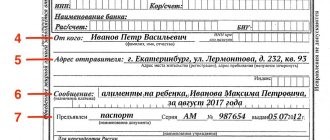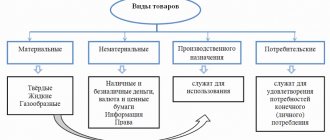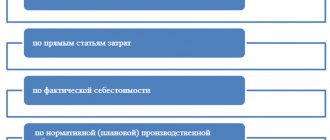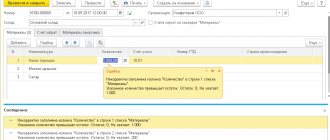Materials are the main element of current assets, which are used as an intermediate element in the activities of the organization. Let's look at the basic accounting entries for writing off materials for production, sale and damage.
The receipt of materials into the organization is recorded at the actual purchase price (excluding VAT).
Accounting for the consumption (issue) of materials into production. Accounting entries
The release of materials into production means their release from the organization's warehouse (shops) directly for the manufacture of products (performance of work, provision of services), as well as the consumption of materials for the management needs of the organization.
The release of materials to the warehouses of departments (shops) of the organization and to construction sites is considered as internal movement.
As materials are released from the warehouses of departments (shops) to workplaces, they are written off from the material asset accounts and credited to the corresponding production cost accounts. The cost of materials released for management needs is charged to the appropriate accounts for accounting for these expenses.
The primary accounting documents for the release (consumption) of materials from the organization's warehouses to the organization's divisions (shops) are a limit-fetch card (standard interindustry form N M-8), a demand invoice (standard interindustry form N M-11), an invoice (standard interindustry form form N M-15).
Write-off of goods in 1C 8.3 - step-by-step instructions
Every organization periodically faces a situation when it is necessary to write off a product due to damage, non-repairability, for business or office needs. It also often happens that during the inventory the goods are not found. When renting 1C, the actions will be similar.
Write-offs can be made in two ways:
- Based on inventory - automatically.
- A separate document - manually.
In each case, a “Write-off of goods” is created, the only difference is in the process. When preparing a separate document, filling out is carried out manually, and based on the inventory, all data is transferred automatically. Let's first create the document “Inventory of goods”. Based on it, it is possible to create two documents:
- Posting of goods.
- Write-off of goods.
Go to the “Warehouse” menu tab and select the “Goods Inventory” item. Press the “Create” button. An empty form opens:
Filling can be done by warehouse or by the person in charge. For example, let's choose a warehouse. Now you need to add a product. This can be done through the “Add” button by selecting each item separately. This method is used only when you need to account for a small quantity of goods. If the inventory is carried out for all the goods that are in the warehouse, then to do this, press the “Fill” button and select the “Fill according to warehouse balances” item. The 1C program in the cloud will enter into the document the entire number of product units that are listed in the selected warehouse. Pay attention to the display of the number in the columns “Actual Quantity” and “Accounting Quantity”. They are equal. And in the “Deviation” column nothing is indicated, that is, it is zero:
This document must be recorded, printed and sent to the warehouse to calculate the actual number of product units. Let's say it turns out that there is less of one product than is listed in the program, and more of another. The correct data is entered manually in the “Actual Quantity” column. And the deviation is immediately displayed:
For proper registration, you need to fill out the remaining two tabs in the document: “Inventory” and “Inventory commission”. We carry it out. The purpose of inventory is to align the balances of goods that are in the warehouse with the balances that are listed in the 1C program in the cloud. Therefore, it is necessary to create two documents - capitalization of unaccounted goods and write-off of missing goods. Let's focus on write-offs. This action is carried out through the “Create based on” button. Click and select the item “Write-off of goods”. The completed document form opens:
There is no need to change anything here, click “Pass and close”. Now let's look at the wiring:
You can see that the goods were previously listed on the credit account of accounting 41.01 (Goods in warehouses) and were written off to debit account 94. A similar posting in cloud 1C would have been formed when generating a separate document “Write-off of goods” (manually). In this case, you would have to enter all the data yourself.
List of accounts involved in accounting entries:
|
|
Below are accounting entries reflecting the consumption of materials for production and administrative needs.
| Account Dt | Kt account | Wiring Description | Transaction amount | A document base |
| 20 | 10 | Materials were released into main production. The consumption of materials in the main production is taken into account | Cost of materials | Limit-fence card (TMF No. M-8) Demand-invoice (TMF No. M-11) Invoice (TMF No. M-15) |
| 23 | 10 | Materials were released to auxiliary production. Material consumption taken into account | Cost of materials | Limit-fence card (TMF No. M-8) Demand-invoice (TMF No. M-11) Invoice (TMF No. M-15) |
| 25 | 10 | Materials were released for general production needs. Material consumption taken into account | Cost of materials | Limit-fence card (TMF No. M-8) Demand-invoice (TMF No. M-11) Invoice (TMF No. M-15) |
| 26 | 10 | Materials were released for general business needs. Material consumption taken into account | Cost of materials | Limit-fence card (TMF No. M-8) Demand-invoice (TMF No. M-11) Invoice (TMF No. M-15) |
| 10 | 10 | Materials were released to warehouses (storerooms) of departments (shops) | Cost of materials | Internal movement invoice |
Accounting for other disposals (write-offs, gratuitous transfers) of materials. Accounting entries
Write-off of materials can be carried out in the following cases:
- that have become unusable after expiration of the storage period;
- obsolete;
- when identifying shortages, thefts or damage, including due to accidents, fires, and natural disasters.
The preparation of the necessary information for making a decision on the write-off of materials is carried out by the Commission with the participation of financially responsible persons. Based on the results of the inspection, the Commission draws up an Act on the write-off of materials for each division of the organization, for financially responsible persons.
The write-off of materials transferred under a gift agreement or free of charge is carried out on the basis of primary documents for the release of materials (waybills, applications for the release of materials to third parties, etc.). Article 146 “Object of taxation” of the Tax Code of the Russian Federation states that the transfer of ownership of assets free of charge is recognized as a sale, that is, subject to VAT.
Below are accounting entries reflecting the write-off and gratuitous transfer of materials
| Account Dt | Kt account | Wiring Description | Transaction amount | A document base |
| Accounting for shortages (damage) of materials in the presence of culprits | ||||
| 94 | 10 | The write-off of the book value of materials is reflected based on the write-off report drawn up by the commission | Actual cost of written-off materials | Material write-off act |
| 20 | 94 | The write-off of shortages (losses from spoilage) of materials is reflected within the approved norms of natural loss due to the expenses of the main production | Natural loss rate | Accounting certificate-calculation Act of write-off of materials |
| 23 | 94 | The write-off of shortages (losses from spoilage) of materials is reflected within the approved norms of natural loss due to the costs of auxiliary production | Natural loss rate | Accounting certificate-calculation Act of write-off of materials |
| 25 | 94 | The write-off of shortages (losses from spoilage) of materials is reflected within the approved norms of natural loss at the expense of overhead costs | Natural loss rate | Accounting certificate-calculation Act of write-off of materials |
| 26 | 94 | The write-off of shortages (losses from spoilage) of materials is reflected within the approved norms of natural loss at the expense of general business expenses | Natural loss rate | Accounting certificate-calculation Act of write-off of materials |
| 29 | 94 | The write-off of shortages (losses from spoilage) of materials is reflected within the approved norms of natural loss due to the costs of service industries | Natural loss rate | Accounting certificate-calculation Act of write-off of materials |
| 73.2 | 94 | The write-off of shortages (losses from spoilage) of materials to the perpetrators in excess of the norms of natural loss is reflected | The amount of excess of the norm of natural loss | Accounting certificate-calculation Act of write-off of materials |
| 91.2 | 68.2 | VAT, previously claimed for deduction, was restored for shortages (losses) of materials in excess of the norms of natural loss | VAT amount | Accounting certificate-calculationInvoice |
| 50.01 | 73.2 | Repayment by the guilty person of the debt for cash shortages is reflected | Shortfall amount | Receipt cash order. Form No. KO-1 |
| 70 | 73.2 | Repayment by the guilty person of the debt for shortfalls at the expense of wages is reflected | Shortfall amount | Accounting certificate-calculation |
| Features of accounting for shortages (damage) of materials in the absence of perpetrators. In this situation, the amount exceeding the natural loss rate is written off not to account 73, but to account 91 | ||||
| 91.2 | 94 | Reflects the write-off of shortages (losses from spoilage) of materials in excess of the norms of natural loss in the absence of guilty persons or shortages, the recovery of which was refused by the court | The amount of excess of the norm of natural loss | Accounting certificate-calculation Act of write-off of materials |
| Accounting for material loss due to natural disasters | ||||
| 99 | 10 | Recorded write-off of materials lost as a result of natural disasters | Cost of lost materials | Material write-off act |
| 99 | 68.2 | VAT, previously claimed for deduction, was restored on lost materials | VAT amount | Accounting certificate-calculationInvoice |
| Accounting for free transfer of materials | ||||
| 91.2 | 10 | Disposal of materials reflected | Actual cost of materials | Invoice (TMF No. M-15) Invoice |
| 91.2 | 68.2 | VAT is charged to the budget on the cost of materials donated free of charge | VAT amount | Invoice (TMF No. M-15) Invoice Sales book |
Postings for writing off materials due to damage
Materials can be:
- stolen
- become obsolete morally and physically,
- be destroyed by an accident, etc.
In this case, organizations write off these materials as other non-operating expenses. Write-off is carried out on the basis of an inventory sheet confirming the destruction or depreciation of materials, and an act of write-off of inventory items.
There is also a rate of natural loss of materials, within which materials are written off to the production due to which the natural loss occurred.
Postings:
| Account Debit | Account Credit | Description | Sum | A document base |
| Disaster: | ||||
| 99.01.1 | 10.01 | Write-off of materials from the balance sheet | Cost price | Write-off act |
| 99.01.1 | 68.02 | Recovering VAT on written-off materials | VAT | Invoice Accounting certificate-calculation |
| Write-off of materials in the absence/presence of perpetrators: | ||||
| 10.01 | Write-off of materials from the balance sheet | Cost price | Write-off act | |
| 91.02 | No person at fault: Write-off of materials | Excess amount | Write-off act Help-calculation | |
| 73.02 | There is a culprit: Writing off the loss of materials to the culprits (above the norm of natural loss) | Excess amount | ||
| 91.02 | 68.02 | Restoration of VAT for shortfalls (exceeding the norm) | VAT | |
Accounting for the sale of materials. Accounting entries
When an organization sells materials to individuals and legal entities, the sales price is determined by agreement of the parties (seller and buyer). The calculation and payment of taxes is carried out by the organization in the manner prescribed by current legislation.
The sale of materials is formalized by issuing an invoice for the release of materials to the third party, on the basis of contracts or other documents and an invoice. When transporting goods by road, a consignment note is issued.
The following are accounting entries reflecting the sale of materials.
| Account Dt | Kt account | Wiring Description | Transaction amount | A document base |
| Sale of materials with payment after shipment (transfer) | ||||
| 91.2 | 10 | The disposal of materials is reflected. The posting amount depends on the methodology for estimating the cost of materials upon disposal (at the cost of each unit, at the average cost, using the FIFO method) | Cost of materials | Invoice (TMF No. M-15) |
| 62.01 | 90.1 | Revenue is reflected in the sales cost of materials including VAT. | Sales cost of materials (amount including VAT) | Invoice (TMF No. M-15) Invoice |
| 91.2 | 68.2 | The amount of VAT on materials sold is reflected | VAT amount | Invoice (TMF No. M-15) Invoice Sales book |
| 51 | 62.01 | The fact of repayment of the buyer’s debt for previously shipped materials is reflected. | Selling cost of materials | Bank statementPayment order |
| Sale of materials on prepayment | ||||
| 51 | 62.02 | The buyer's prepayment for materials is reflected | Advance payment amount | Bank statementPayment order |
| 76.AB | 68.2 | VAT is charged on advance payment | VAT amount | Payment orderInvoiceSales book |
| 91.2 | 10 | The disposal of materials is reflected. The posting amount depends on the methodology for estimating the cost of materials upon disposal (at the cost of each unit, at the average cost, using the FIFO method) | Cost of materials | Invoice (TMF No. M-15) |
| 62.01 | 91.1 | Revenue is reflected in the sales cost of materials including VAT. | Sales cost of materials. Value with VAT | Invoice (TMF No. M-15) Invoice |
| 91.2 | 68.2 | VAT is charged on materials sold | VAT amount | Invoice (TMF No. M-15) Invoice |
| 62.01 | 62.02 | The previously received prepayment is offset against the debt for the transferred materials. | Advance payment amount | Accounting certificate-calculation |
| 68.2 | 76.AB | VAT is credited from the prepaid payment | VAT amount | InvoicePurchase book |
Postings for the sale of materials
An organization can sell materials it does not need to third parties at a price that satisfies both of them, which for the organization will be other expenses and income.
Typical wiring:
| Account Debit | Account Credit | Description | Sum | A document base |
| 91.02 | 10.01 | Disposal of materials | Cost (FIFO, weighted average or piece cost) | Invoice |
| 62.01 | 90.01 | Revenue from sales of materials | Sales price (including VAT) | Invoice Invoice |
| 91.02 | 68.02 | VAT on the sale price | VAT amount | Invoice Invoice Sales book |
| 62.01 | Payment by the buyer for shipped materials | Sales price | Payment order Bank statement |







